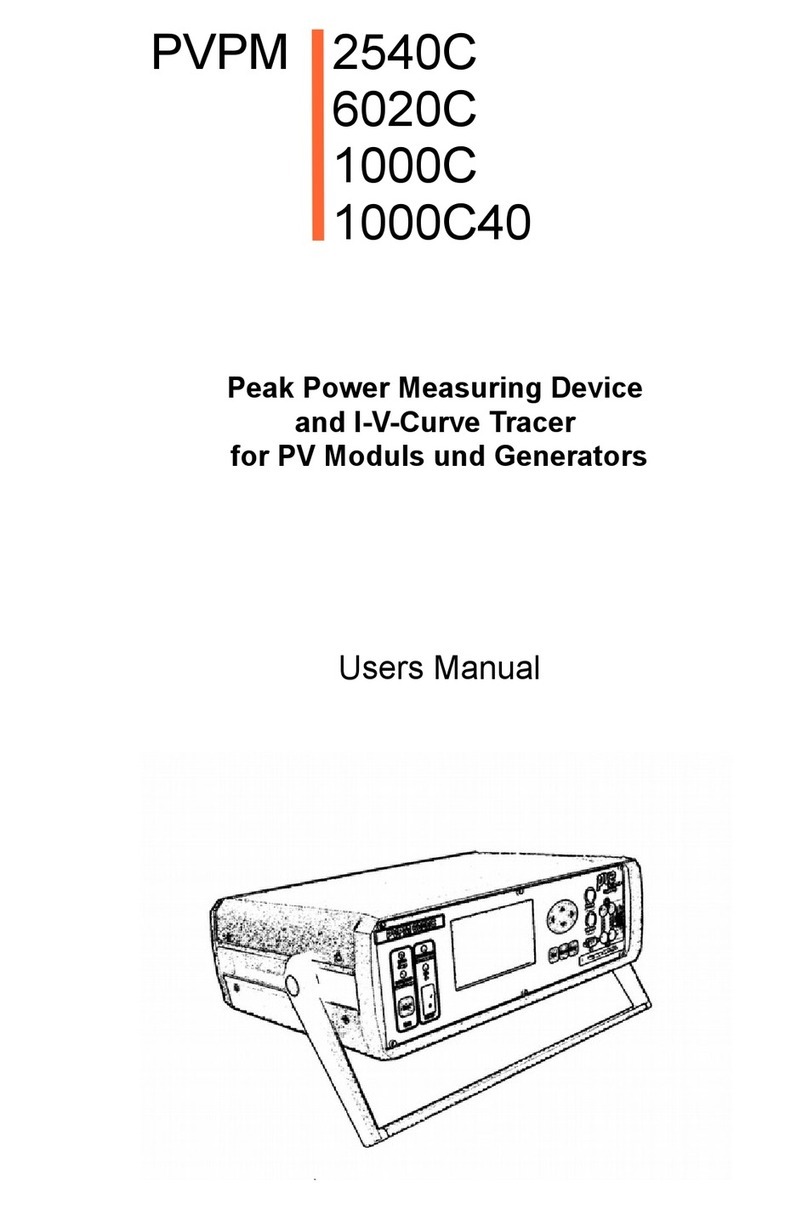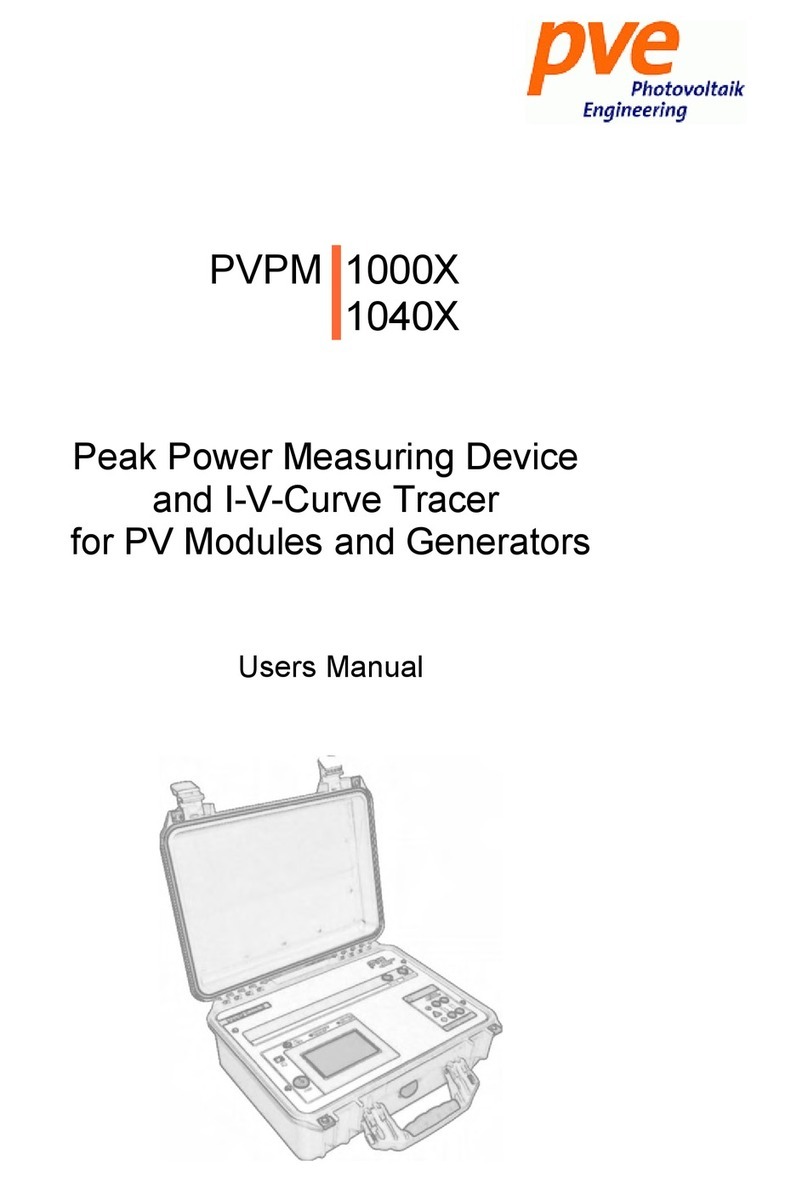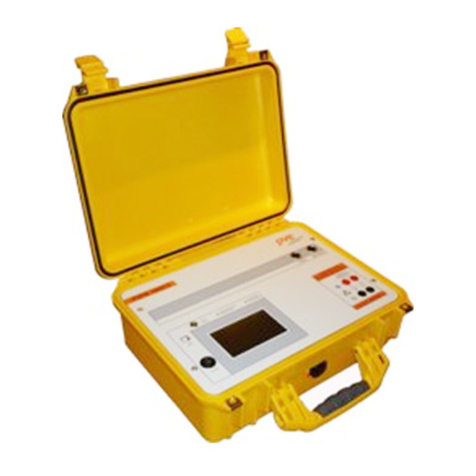1 Content -2-
1 Content
1 CONTENT.................................................................................................................................................................... 2
2 SOFTWARE END USER LICENSE AGREEMENT........................................................................................................4
3 INTRODUCTION.......................................................................................................................................................... 5
4 NORMAL USE............................................................................................................................................................. 5
5 SAFETY REQUIREMENTS........................................................................................................................................... 6
6 OPERATION OF THE PVPM........................................................................................................................................ 8
6.1 OPERATING AND CONNECTION ELEMENTS.................................................................................................................................... 8
6.2 GENERAL HINTS................................................................................................................................................................. 9
6.3 CONNECTING PERIPHERAL DEVICES......................................................................................................................................... 9
6.4 POWER SUPPLY................................................................................................................................................................ 10
6.5 CONNECTING A PC........................................................................................................................................................... 10
6.6 CONNECTING THE SOLAR GENERATOR....................................................................................................................................10
6.7 CONNECTING THE COM INED SENSOR.................................................................................................................................... 11
6.8 SWITCHING-ON................................................................................................................................................................. 11
6.9 UTTONS........................................................................................................................................................................ 12
6.10 MEASUREMENT............................................................................................................................................................... 13
6.11 MESSAGES.................................................................................................................................................................... 15
7 E TERNAL SECURITY SWITCH 1000V / 32A (40A)..................................................................................................16
8 IMPACTS ON THE ACCURACY OF THE MEASUREMENT.......................................................................................17
9 ACCURACY OF THE PEAK POWER CALCULATIONS FROM I-V CHARACTERISTICS...........................................18
10 INSTALLATION OF THE TRANSFER SOFTWARE PVPM.DISP..............................................................................19
11 INSTALLING THE USB DEVICE DRIVER.................................................................................................................20
11.1 INSTALLATION WITH „NEW HARDWARE FOUND“......................................................................................................................... 20
11.2 UNINSTALLING THE CDM DRIVER........................................................................................................................................ 23
12 OPERATION OF THE SOFTWARE PVPM.DISP.......................................................................................................24
12.1 MAIN MENU FILE........................................................................................................................................................... 24
12.2 EDIT............................................................................................................................................................................ 26
12.3 EXTRA......................................................................................................................................................................... 26
12.4 DIAGRAM...................................................................................................................................................................... 29
12.5 RESULTS / LISTS............................................................................................................................................................ 30
12.6 HELP (NOT YET IMPLEMENTED)............................................................................................................................................ 30
13 HARDWARE INFORMATION...................................................................................................................................32
13.1 MEASURING UNIT:.......................................................................................................................................................... 32
13.2 PINOUT OF SENSOR SOCKETS:............................................................................................................................................ 32
13.3 CALCULATION UNIT:........................................................................................................................................................ 32
13.4 DISPLAY:...................................................................................................................................................................... 32
13.5 OPERATION:.................................................................................................................................................................. 33
13.6 POWER SUPPLY:............................................................................................................................................................. 33
13.7 DIMENSIONS.................................................................................................................................................................. 33
13.8 OPERATION CONDITIONS:.................................................................................................................................................. 33
13.9 OPTIONALLY AVAILA LE:.................................................................................................................................................... 33
14 LIST OF SYMBOLS..................................................................................................................................................34
15 REASONS FOR DECREASED POWER AND YIELD OF PV GENERATORS............................................................35
16 I-U DIAGRAM: E PLANATION................................................................................................................................. 36
17 SAMPLE CURVES.................................................................................................................................................... 41
18 GLOSSARY.............................................................................................................................................................. 44
18.1 AZIMUTH (SS) AND ELEVATION (Α)........................................................................................................................................ 44
18.2 SLOPE......................................................................................................................................................................... 44
18.3 DC............................................................................................................................................................................ 44
18.4 DEGRADATION CHARACTERISTIC........................................................................................................................................... 44
18.5 DIRECT RADIATION/ DIFFUSE RADIATION.................................................................................................................................. 44
18.6 GENERATOR.................................................................................................................................................................. 44
18.7 GLO AL/TOTAL RADIATION.................................................................................................................................................. 45
18.8 SHORT-CIRCUIT CURRENT OF SOLAR CELLS............................................................................................................................. 45
18.9 MISMATCHING................................................................................................................................................................ 45
18.10 MPP........................................................................................................................................................................ 45
18.11 TRACKING................................................................................................................................................................... 45
18.12 PEAK POWER............................................................................................................................................................... 45
18.13 PERFORMANCE RATIO.................................................................................................................................................... 45
18.14 PHOX-SENSOR.............................................................................................................................................................. 45
18.15 INTERNAL SERIES RESISTANCE........................................................................................................................................... 46
18.16 SOLAR CONSTANT......................................................................................................................................................... 46
18.17 SOLAR IRRADIATION / INSOLATION....................................................................................................................................... 46
Operation manual for PVPM devi es PV-Engineering GmbH






























